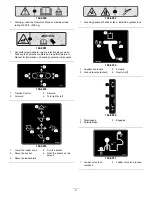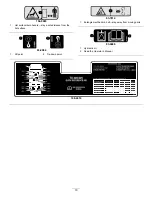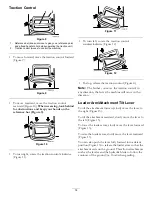
Stability Data
The following tables list the maximum slope recommended for the traction unit in the positions listed in the tables.
Slopes over the listed degree may cause the traction unit to become unstable. The data in the tables assume that the
loader arms are fully lowered; raised arms may affect the stability.
In each attachment manual is a set of three stability ratings, one for each hill position. To determine the maximum
slope you can traverse with the attachment installed, find the degree of slope that corresponds to the stability ratings
of the attachment. Example: If the attachment installed on a TX 420 traction unit has a Front Uphill rating of B, a
Rear Uphill rating of D, and a Side Uphill rating of C, then you could drive forward up a 20° slope, rearward up a 12°
slope, or sideways on a 14° slope, as listed in the following table for the TX 420 traction unit.
TX 420, Model 22331
Maximum Recommended Slope when
Operating with:
Front Uphill
Rear Uphill
Side Uphill
Configuration
Traction unit without attachment
11°
21°
19°
Traction unit with an attachment rated with one of the following stability ratings
for each slope position:*
A
25°
25°
20°
B
20°
20°
18°
C
17°
17°
14°
D
10°
12°
9°
E
5°
5°
5°
TX 425, Model 22332
Maximum Recommended Slope when
Operating with:
Front Uphill
Rear Uphill
Side Uphill
Configuration
Traction unit without attachment
12°
20°
23°
Traction unit with an attachment rated with one of the following stability ratings
for each slope position:*
A
25°
25°
25°
B
22°
22°
22°
C
18°
16°
16°
D
10°
10°
10°
E
5°
5°
5°
18
Содержание 22331 TX 420
Страница 7: ...Slope Chart 7 ...
Страница 48: ...Schematics Electrical Schematic Rev A 48 ...
Страница 49: ...Hydraulic Schematic Rev A 49 ...
Страница 50: ...Notes 50 ...
Страница 51: ...Notes 51 ...





































